Effective Communication Skills in Social Work: A Comprehensive Essay
VerifiedAdded on 2020/05/11
|9
|2184
|398
Essay
AI Summary
This essay provides a comprehensive overview of communication skills in social work, emphasizing their importance in the helping process. It details the five stages of this process: rapport and relationship building, assessment, goal setting, intervention, and termination, highlighting the critical role of communication in each stage. The essay also identifies various barriers to effective communication, including emotional barriers, cultural and language differences, use of jargon, prejudices, non-verbal cues, and lack of attention. Furthermore, it offers practical recommendations to overcome these barriers, such as using simple language, practicing active listening, maintaining clarity in thoughts, staying calm, avoiding information overload, providing feedback, and understanding body language. The essay concludes by underscoring the significance of effective communication in fostering trust, building relationships, and ultimately achieving successful outcomes in the helping process within social work.
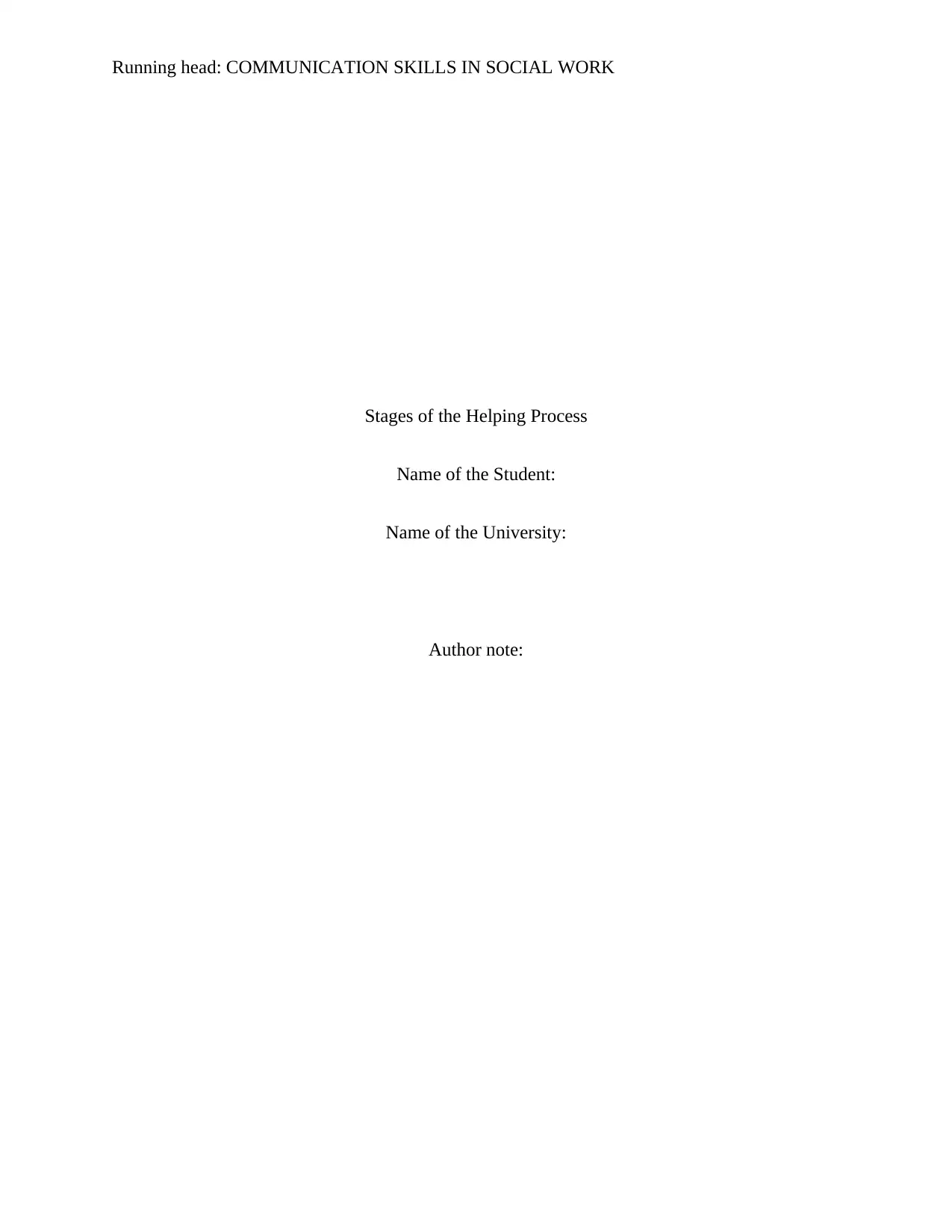
Running head: COMMUNICATION SKILLS IN SOCIAL WORK
Stages of the Helping Process
Name of the Student:
Name of the University:
Author note:
Stages of the Helping Process
Name of the Student:
Name of the University:
Author note:
Secure Best Marks with AI Grader
Need help grading? Try our AI Grader for instant feedback on your assignments.
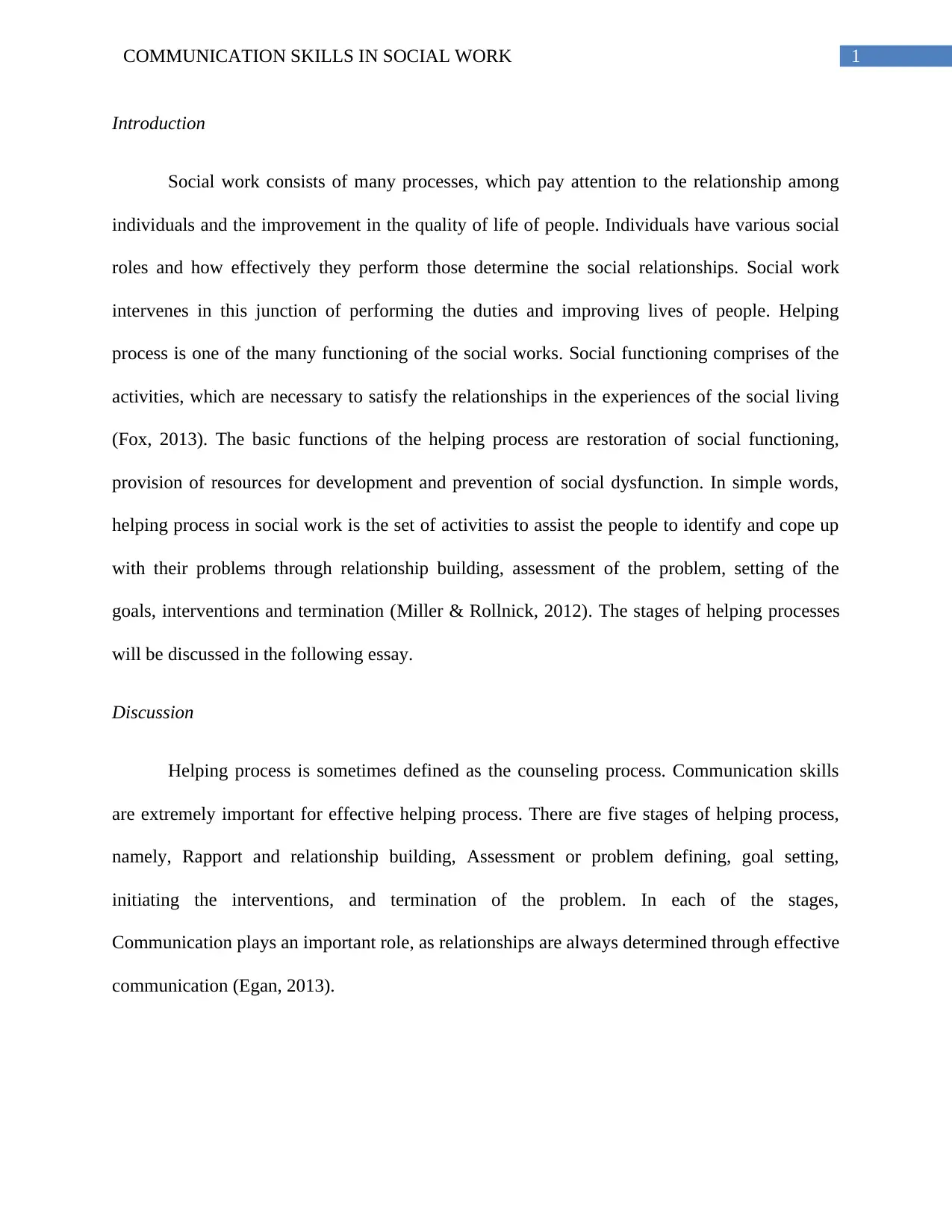
1COMMUNICATION SKILLS IN SOCIAL WORK
Introduction
Social work consists of many processes, which pay attention to the relationship among
individuals and the improvement in the quality of life of people. Individuals have various social
roles and how effectively they perform those determine the social relationships. Social work
intervenes in this junction of performing the duties and improving lives of people. Helping
process is one of the many functioning of the social works. Social functioning comprises of the
activities, which are necessary to satisfy the relationships in the experiences of the social living
(Fox, 2013). The basic functions of the helping process are restoration of social functioning,
provision of resources for development and prevention of social dysfunction. In simple words,
helping process in social work is the set of activities to assist the people to identify and cope up
with their problems through relationship building, assessment of the problem, setting of the
goals, interventions and termination (Miller & Rollnick, 2012). The stages of helping processes
will be discussed in the following essay.
Discussion
Helping process is sometimes defined as the counseling process. Communication skills
are extremely important for effective helping process. There are five stages of helping process,
namely, Rapport and relationship building, Assessment or problem defining, goal setting,
initiating the interventions, and termination of the problem. In each of the stages,
Communication plays an important role, as relationships are always determined through effective
communication (Egan, 2013).
Introduction
Social work consists of many processes, which pay attention to the relationship among
individuals and the improvement in the quality of life of people. Individuals have various social
roles and how effectively they perform those determine the social relationships. Social work
intervenes in this junction of performing the duties and improving lives of people. Helping
process is one of the many functioning of the social works. Social functioning comprises of the
activities, which are necessary to satisfy the relationships in the experiences of the social living
(Fox, 2013). The basic functions of the helping process are restoration of social functioning,
provision of resources for development and prevention of social dysfunction. In simple words,
helping process in social work is the set of activities to assist the people to identify and cope up
with their problems through relationship building, assessment of the problem, setting of the
goals, interventions and termination (Miller & Rollnick, 2012). The stages of helping processes
will be discussed in the following essay.
Discussion
Helping process is sometimes defined as the counseling process. Communication skills
are extremely important for effective helping process. There are five stages of helping process,
namely, Rapport and relationship building, Assessment or problem defining, goal setting,
initiating the interventions, and termination of the problem. In each of the stages,
Communication plays an important role, as relationships are always determined through effective
communication (Egan, 2013).
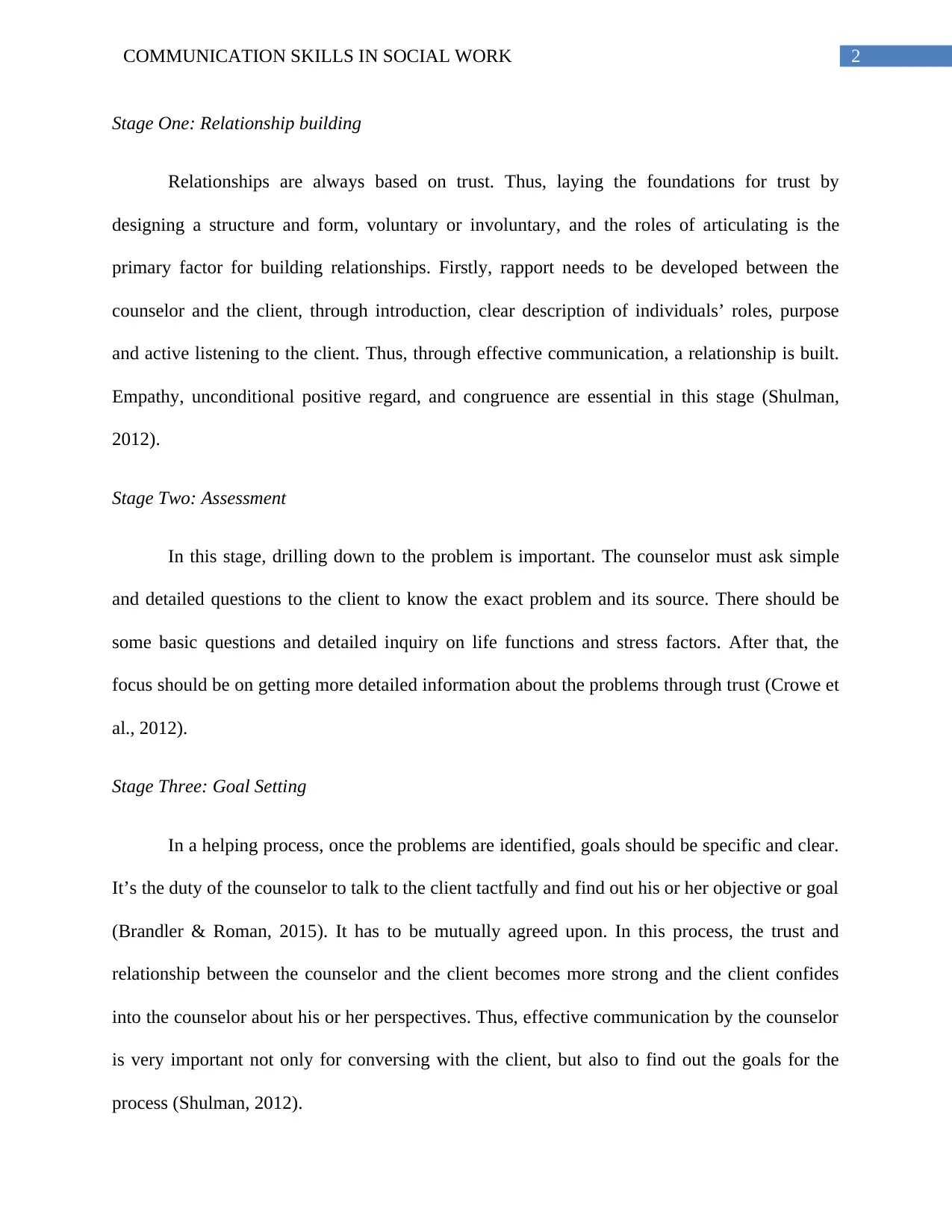
2COMMUNICATION SKILLS IN SOCIAL WORK
Stage One: Relationship building
Relationships are always based on trust. Thus, laying the foundations for trust by
designing a structure and form, voluntary or involuntary, and the roles of articulating is the
primary factor for building relationships. Firstly, rapport needs to be developed between the
counselor and the client, through introduction, clear description of individuals’ roles, purpose
and active listening to the client. Thus, through effective communication, a relationship is built.
Empathy, unconditional positive regard, and congruence are essential in this stage (Shulman,
2012).
Stage Two: Assessment
In this stage, drilling down to the problem is important. The counselor must ask simple
and detailed questions to the client to know the exact problem and its source. There should be
some basic questions and detailed inquiry on life functions and stress factors. After that, the
focus should be on getting more detailed information about the problems through trust (Crowe et
al., 2012).
Stage Three: Goal Setting
In a helping process, once the problems are identified, goals should be specific and clear.
It’s the duty of the counselor to talk to the client tactfully and find out his or her objective or goal
(Brandler & Roman, 2015). It has to be mutually agreed upon. In this process, the trust and
relationship between the counselor and the client becomes more strong and the client confides
into the counselor about his or her perspectives. Thus, effective communication by the counselor
is very important not only for conversing with the client, but also to find out the goals for the
process (Shulman, 2012).
Stage One: Relationship building
Relationships are always based on trust. Thus, laying the foundations for trust by
designing a structure and form, voluntary or involuntary, and the roles of articulating is the
primary factor for building relationships. Firstly, rapport needs to be developed between the
counselor and the client, through introduction, clear description of individuals’ roles, purpose
and active listening to the client. Thus, through effective communication, a relationship is built.
Empathy, unconditional positive regard, and congruence are essential in this stage (Shulman,
2012).
Stage Two: Assessment
In this stage, drilling down to the problem is important. The counselor must ask simple
and detailed questions to the client to know the exact problem and its source. There should be
some basic questions and detailed inquiry on life functions and stress factors. After that, the
focus should be on getting more detailed information about the problems through trust (Crowe et
al., 2012).
Stage Three: Goal Setting
In a helping process, once the problems are identified, goals should be specific and clear.
It’s the duty of the counselor to talk to the client tactfully and find out his or her objective or goal
(Brandler & Roman, 2015). It has to be mutually agreed upon. In this process, the trust and
relationship between the counselor and the client becomes more strong and the client confides
into the counselor about his or her perspectives. Thus, effective communication by the counselor
is very important not only for conversing with the client, but also to find out the goals for the
process (Shulman, 2012).
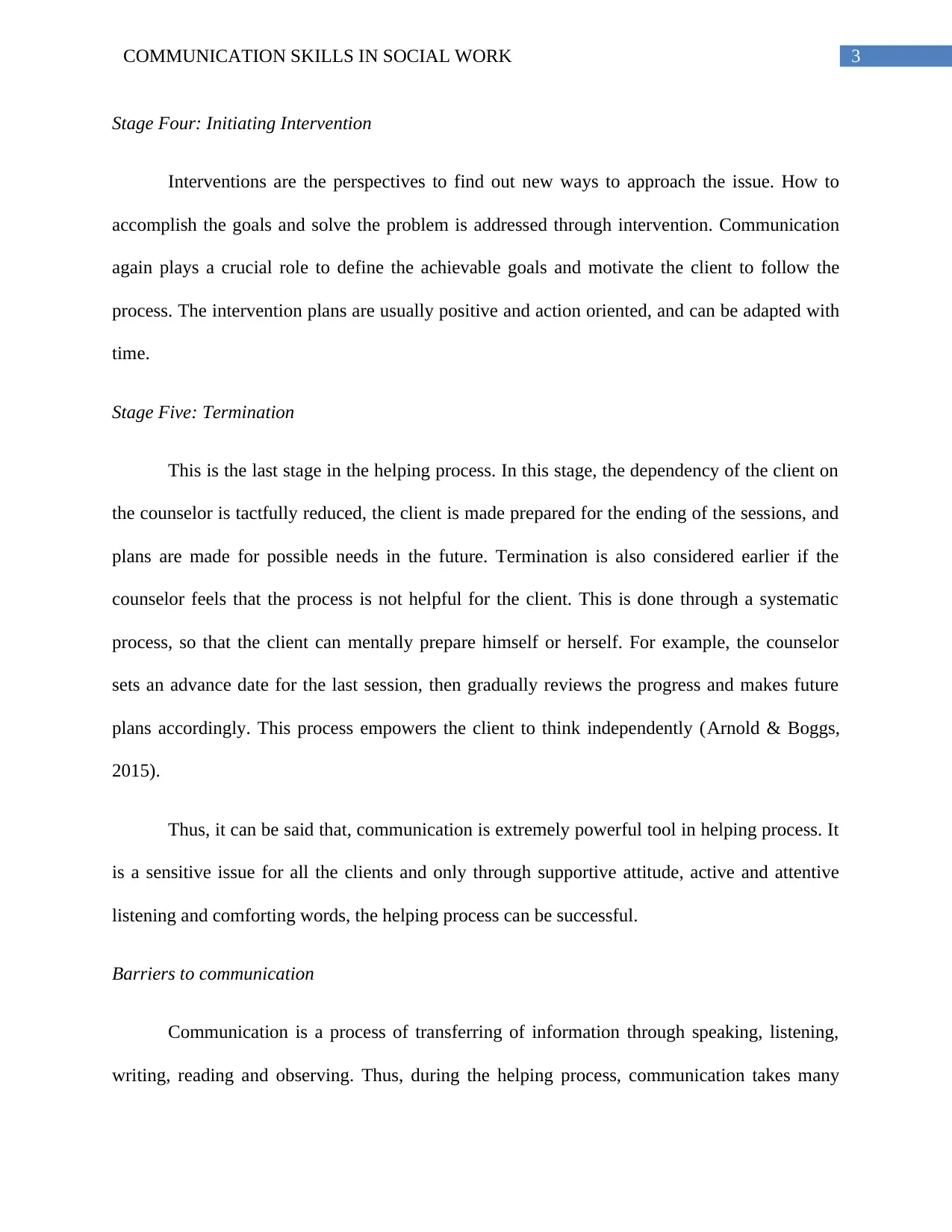
3COMMUNICATION SKILLS IN SOCIAL WORK
Stage Four: Initiating Intervention
Interventions are the perspectives to find out new ways to approach the issue. How to
accomplish the goals and solve the problem is addressed through intervention. Communication
again plays a crucial role to define the achievable goals and motivate the client to follow the
process. The intervention plans are usually positive and action oriented, and can be adapted with
time.
Stage Five: Termination
This is the last stage in the helping process. In this stage, the dependency of the client on
the counselor is tactfully reduced, the client is made prepared for the ending of the sessions, and
plans are made for possible needs in the future. Termination is also considered earlier if the
counselor feels that the process is not helpful for the client. This is done through a systematic
process, so that the client can mentally prepare himself or herself. For example, the counselor
sets an advance date for the last session, then gradually reviews the progress and makes future
plans accordingly. This process empowers the client to think independently (Arnold & Boggs,
2015).
Thus, it can be said that, communication is extremely powerful tool in helping process. It
is a sensitive issue for all the clients and only through supportive attitude, active and attentive
listening and comforting words, the helping process can be successful.
Barriers to communication
Communication is a process of transferring of information through speaking, listening,
writing, reading and observing. Thus, during the helping process, communication takes many
Stage Four: Initiating Intervention
Interventions are the perspectives to find out new ways to approach the issue. How to
accomplish the goals and solve the problem is addressed through intervention. Communication
again plays a crucial role to define the achievable goals and motivate the client to follow the
process. The intervention plans are usually positive and action oriented, and can be adapted with
time.
Stage Five: Termination
This is the last stage in the helping process. In this stage, the dependency of the client on
the counselor is tactfully reduced, the client is made prepared for the ending of the sessions, and
plans are made for possible needs in the future. Termination is also considered earlier if the
counselor feels that the process is not helpful for the client. This is done through a systematic
process, so that the client can mentally prepare himself or herself. For example, the counselor
sets an advance date for the last session, then gradually reviews the progress and makes future
plans accordingly. This process empowers the client to think independently (Arnold & Boggs,
2015).
Thus, it can be said that, communication is extremely powerful tool in helping process. It
is a sensitive issue for all the clients and only through supportive attitude, active and attentive
listening and comforting words, the helping process can be successful.
Barriers to communication
Communication is a process of transferring of information through speaking, listening,
writing, reading and observing. Thus, during the helping process, communication takes many
Secure Best Marks with AI Grader
Need help grading? Try our AI Grader for instant feedback on your assignments.
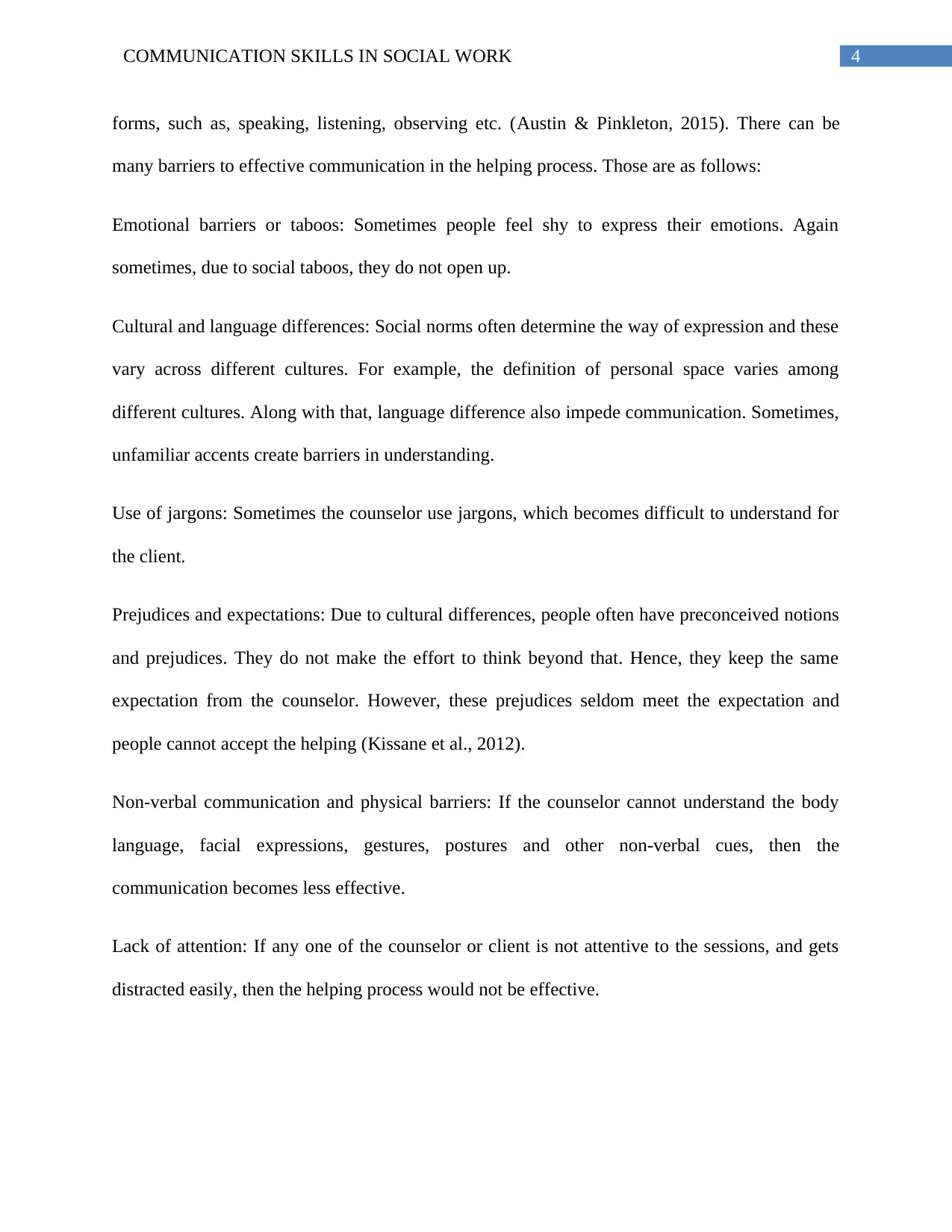
4COMMUNICATION SKILLS IN SOCIAL WORK
forms, such as, speaking, listening, observing etc. (Austin & Pinkleton, 2015). There can be
many barriers to effective communication in the helping process. Those are as follows:
Emotional barriers or taboos: Sometimes people feel shy to express their emotions. Again
sometimes, due to social taboos, they do not open up.
Cultural and language differences: Social norms often determine the way of expression and these
vary across different cultures. For example, the definition of personal space varies among
different cultures. Along with that, language difference also impede communication. Sometimes,
unfamiliar accents create barriers in understanding.
Use of jargons: Sometimes the counselor use jargons, which becomes difficult to understand for
the client.
Prejudices and expectations: Due to cultural differences, people often have preconceived notions
and prejudices. They do not make the effort to think beyond that. Hence, they keep the same
expectation from the counselor. However, these prejudices seldom meet the expectation and
people cannot accept the helping (Kissane et al., 2012).
Non-verbal communication and physical barriers: If the counselor cannot understand the body
language, facial expressions, gestures, postures and other non-verbal cues, then the
communication becomes less effective.
Lack of attention: If any one of the counselor or client is not attentive to the sessions, and gets
distracted easily, then the helping process would not be effective.
forms, such as, speaking, listening, observing etc. (Austin & Pinkleton, 2015). There can be
many barriers to effective communication in the helping process. Those are as follows:
Emotional barriers or taboos: Sometimes people feel shy to express their emotions. Again
sometimes, due to social taboos, they do not open up.
Cultural and language differences: Social norms often determine the way of expression and these
vary across different cultures. For example, the definition of personal space varies among
different cultures. Along with that, language difference also impede communication. Sometimes,
unfamiliar accents create barriers in understanding.
Use of jargons: Sometimes the counselor use jargons, which becomes difficult to understand for
the client.
Prejudices and expectations: Due to cultural differences, people often have preconceived notions
and prejudices. They do not make the effort to think beyond that. Hence, they keep the same
expectation from the counselor. However, these prejudices seldom meet the expectation and
people cannot accept the helping (Kissane et al., 2012).
Non-verbal communication and physical barriers: If the counselor cannot understand the body
language, facial expressions, gestures, postures and other non-verbal cues, then the
communication becomes less effective.
Lack of attention: If any one of the counselor or client is not attentive to the sessions, and gets
distracted easily, then the helping process would not be effective.
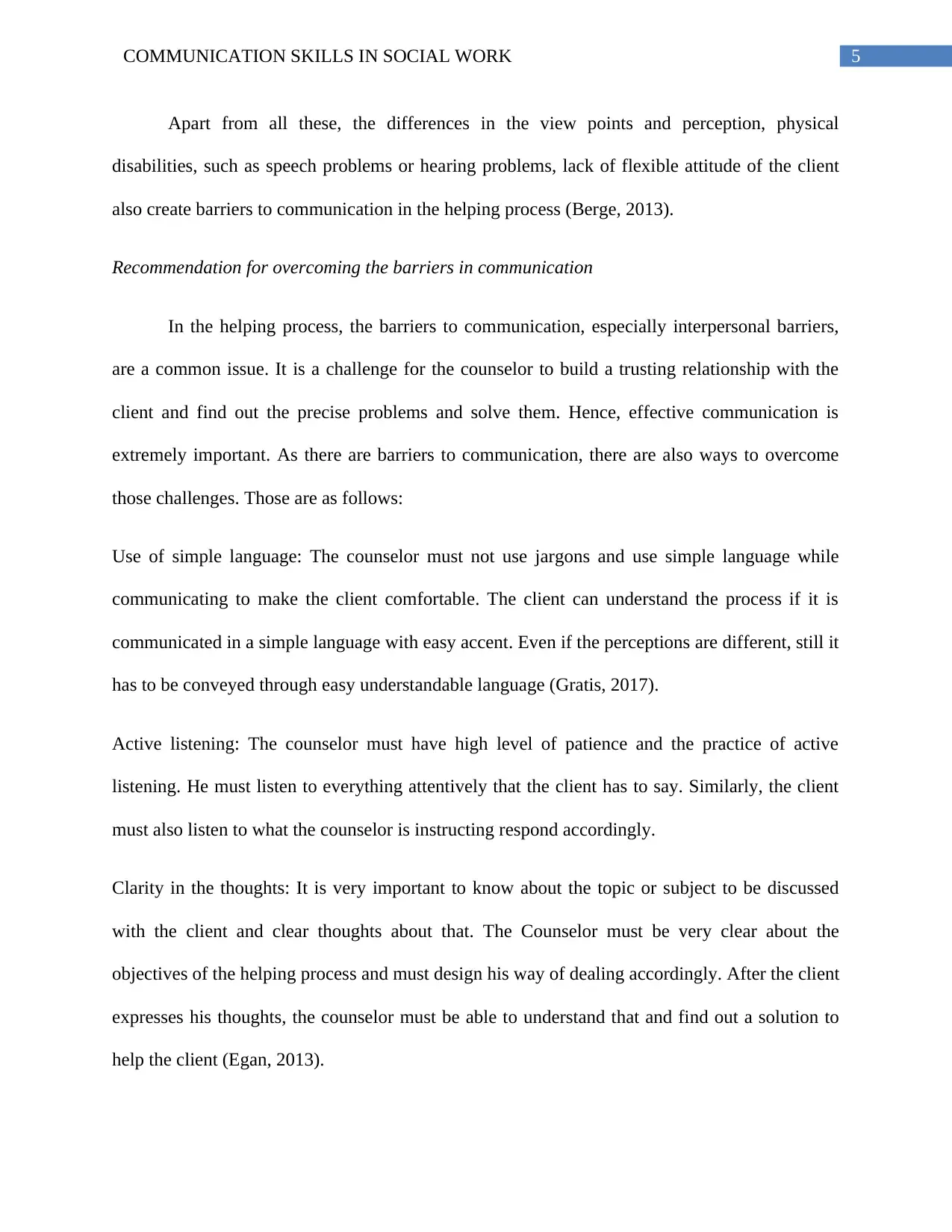
5COMMUNICATION SKILLS IN SOCIAL WORK
Apart from all these, the differences in the view points and perception, physical
disabilities, such as speech problems or hearing problems, lack of flexible attitude of the client
also create barriers to communication in the helping process (Berge, 2013).
Recommendation for overcoming the barriers in communication
In the helping process, the barriers to communication, especially interpersonal barriers,
are a common issue. It is a challenge for the counselor to build a trusting relationship with the
client and find out the precise problems and solve them. Hence, effective communication is
extremely important. As there are barriers to communication, there are also ways to overcome
those challenges. Those are as follows:
Use of simple language: The counselor must not use jargons and use simple language while
communicating to make the client comfortable. The client can understand the process if it is
communicated in a simple language with easy accent. Even if the perceptions are different, still it
has to be conveyed through easy understandable language (Gratis, 2017).
Active listening: The counselor must have high level of patience and the practice of active
listening. He must listen to everything attentively that the client has to say. Similarly, the client
must also listen to what the counselor is instructing respond accordingly.
Clarity in the thoughts: It is very important to know about the topic or subject to be discussed
with the client and clear thoughts about that. The Counselor must be very clear about the
objectives of the helping process and must design his way of dealing accordingly. After the client
expresses his thoughts, the counselor must be able to understand that and find out a solution to
help the client (Egan, 2013).
Apart from all these, the differences in the view points and perception, physical
disabilities, such as speech problems or hearing problems, lack of flexible attitude of the client
also create barriers to communication in the helping process (Berge, 2013).
Recommendation for overcoming the barriers in communication
In the helping process, the barriers to communication, especially interpersonal barriers,
are a common issue. It is a challenge for the counselor to build a trusting relationship with the
client and find out the precise problems and solve them. Hence, effective communication is
extremely important. As there are barriers to communication, there are also ways to overcome
those challenges. Those are as follows:
Use of simple language: The counselor must not use jargons and use simple language while
communicating to make the client comfortable. The client can understand the process if it is
communicated in a simple language with easy accent. Even if the perceptions are different, still it
has to be conveyed through easy understandable language (Gratis, 2017).
Active listening: The counselor must have high level of patience and the practice of active
listening. He must listen to everything attentively that the client has to say. Similarly, the client
must also listen to what the counselor is instructing respond accordingly.
Clarity in the thoughts: It is very important to know about the topic or subject to be discussed
with the client and clear thoughts about that. The Counselor must be very clear about the
objectives of the helping process and must design his way of dealing accordingly. After the client
expresses his thoughts, the counselor must be able to understand that and find out a solution to
help the client (Egan, 2013).
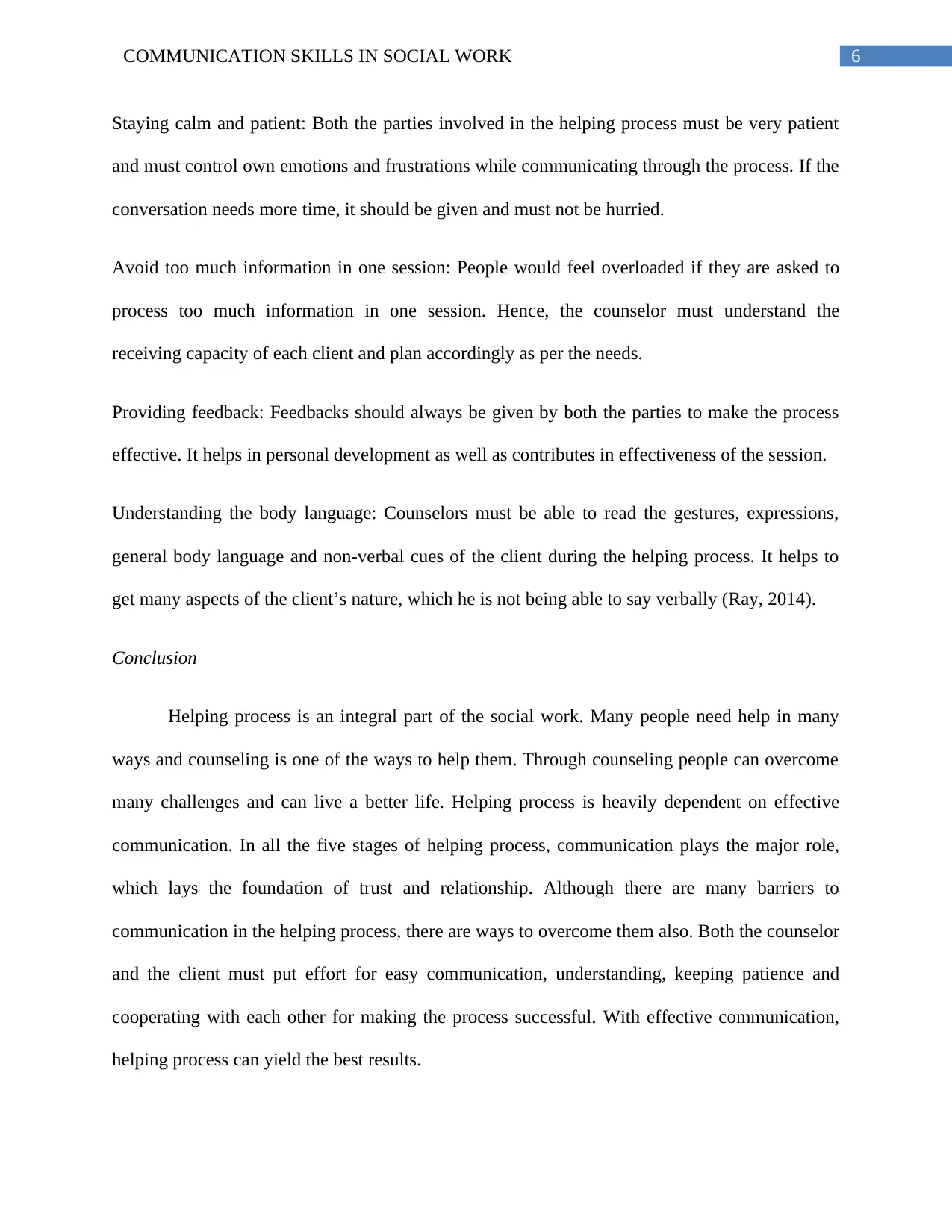
6COMMUNICATION SKILLS IN SOCIAL WORK
Staying calm and patient: Both the parties involved in the helping process must be very patient
and must control own emotions and frustrations while communicating through the process. If the
conversation needs more time, it should be given and must not be hurried.
Avoid too much information in one session: People would feel overloaded if they are asked to
process too much information in one session. Hence, the counselor must understand the
receiving capacity of each client and plan accordingly as per the needs.
Providing feedback: Feedbacks should always be given by both the parties to make the process
effective. It helps in personal development as well as contributes in effectiveness of the session.
Understanding the body language: Counselors must be able to read the gestures, expressions,
general body language and non-verbal cues of the client during the helping process. It helps to
get many aspects of the client’s nature, which he is not being able to say verbally (Ray, 2014).
Conclusion
Helping process is an integral part of the social work. Many people need help in many
ways and counseling is one of the ways to help them. Through counseling people can overcome
many challenges and can live a better life. Helping process is heavily dependent on effective
communication. In all the five stages of helping process, communication plays the major role,
which lays the foundation of trust and relationship. Although there are many barriers to
communication in the helping process, there are ways to overcome them also. Both the counselor
and the client must put effort for easy communication, understanding, keeping patience and
cooperating with each other for making the process successful. With effective communication,
helping process can yield the best results.
Staying calm and patient: Both the parties involved in the helping process must be very patient
and must control own emotions and frustrations while communicating through the process. If the
conversation needs more time, it should be given and must not be hurried.
Avoid too much information in one session: People would feel overloaded if they are asked to
process too much information in one session. Hence, the counselor must understand the
receiving capacity of each client and plan accordingly as per the needs.
Providing feedback: Feedbacks should always be given by both the parties to make the process
effective. It helps in personal development as well as contributes in effectiveness of the session.
Understanding the body language: Counselors must be able to read the gestures, expressions,
general body language and non-verbal cues of the client during the helping process. It helps to
get many aspects of the client’s nature, which he is not being able to say verbally (Ray, 2014).
Conclusion
Helping process is an integral part of the social work. Many people need help in many
ways and counseling is one of the ways to help them. Through counseling people can overcome
many challenges and can live a better life. Helping process is heavily dependent on effective
communication. In all the five stages of helping process, communication plays the major role,
which lays the foundation of trust and relationship. Although there are many barriers to
communication in the helping process, there are ways to overcome them also. Both the counselor
and the client must put effort for easy communication, understanding, keeping patience and
cooperating with each other for making the process successful. With effective communication,
helping process can yield the best results.
Paraphrase This Document
Need a fresh take? Get an instant paraphrase of this document with our AI Paraphraser
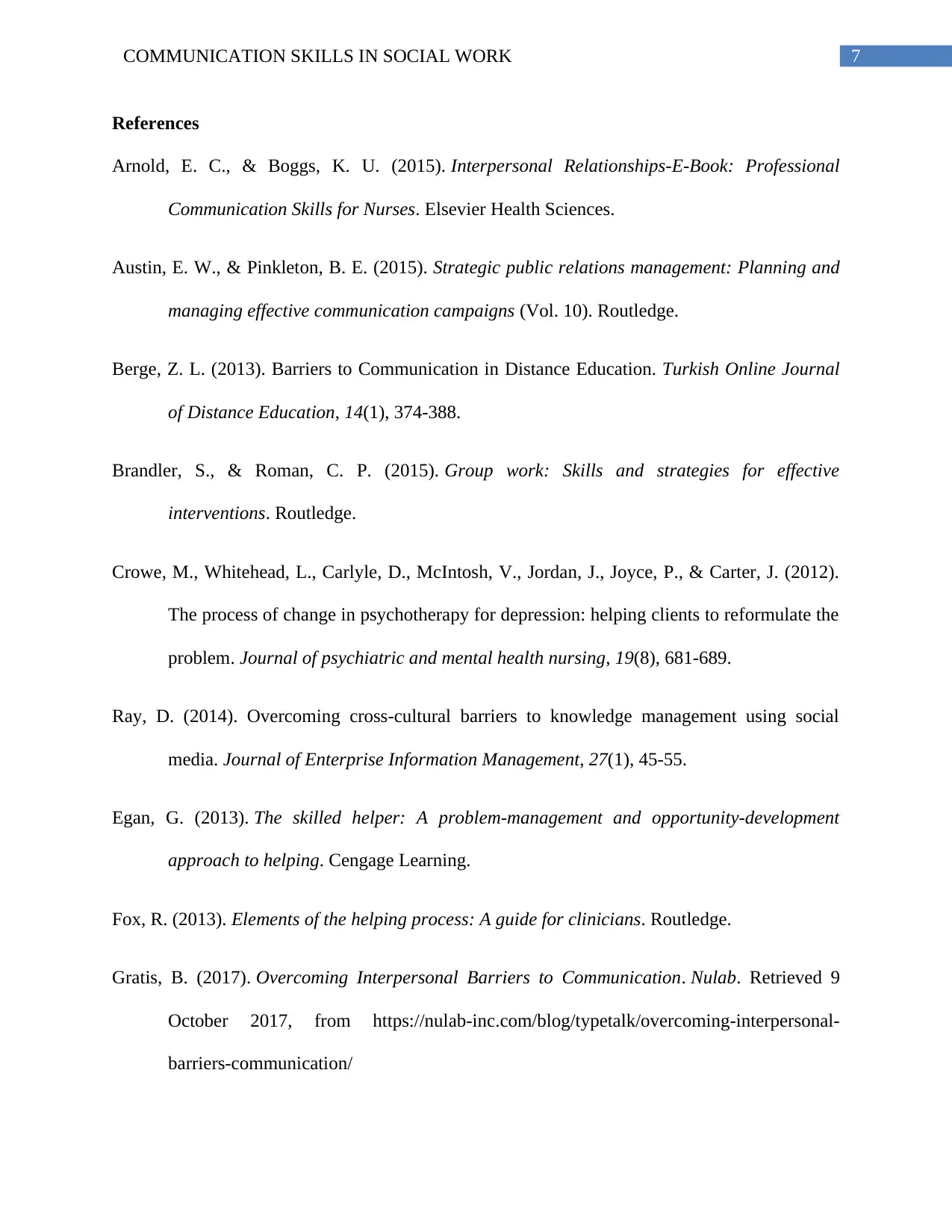
7COMMUNICATION SKILLS IN SOCIAL WORK
References
Arnold, E. C., & Boggs, K. U. (2015). Interpersonal Relationships-E-Book: Professional
Communication Skills for Nurses. Elsevier Health Sciences.
Austin, E. W., & Pinkleton, B. E. (2015). Strategic public relations management: Planning and
managing effective communication campaigns (Vol. 10). Routledge.
Berge, Z. L. (2013). Barriers to Communication in Distance Education. Turkish Online Journal
of Distance Education, 14(1), 374-388.
Brandler, S., & Roman, C. P. (2015). Group work: Skills and strategies for effective
interventions. Routledge.
Crowe, M., Whitehead, L., Carlyle, D., McIntosh, V., Jordan, J., Joyce, P., & Carter, J. (2012).
The process of change in psychotherapy for depression: helping clients to reformulate the
problem. Journal of psychiatric and mental health nursing, 19(8), 681-689.
Ray, D. (2014). Overcoming cross-cultural barriers to knowledge management using social
media. Journal of Enterprise Information Management, 27(1), 45-55.
Egan, G. (2013). The skilled helper: A problem-management and opportunity-development
approach to helping. Cengage Learning.
Fox, R. (2013). Elements of the helping process: A guide for clinicians. Routledge.
Gratis, B. (2017). Overcoming Interpersonal Barriers to Communication. Nulab. Retrieved 9
October 2017, from https://nulab-inc.com/blog/typetalk/overcoming-interpersonal-
barriers-communication/
References
Arnold, E. C., & Boggs, K. U. (2015). Interpersonal Relationships-E-Book: Professional
Communication Skills for Nurses. Elsevier Health Sciences.
Austin, E. W., & Pinkleton, B. E. (2015). Strategic public relations management: Planning and
managing effective communication campaigns (Vol. 10). Routledge.
Berge, Z. L. (2013). Barriers to Communication in Distance Education. Turkish Online Journal
of Distance Education, 14(1), 374-388.
Brandler, S., & Roman, C. P. (2015). Group work: Skills and strategies for effective
interventions. Routledge.
Crowe, M., Whitehead, L., Carlyle, D., McIntosh, V., Jordan, J., Joyce, P., & Carter, J. (2012).
The process of change in psychotherapy for depression: helping clients to reformulate the
problem. Journal of psychiatric and mental health nursing, 19(8), 681-689.
Ray, D. (2014). Overcoming cross-cultural barriers to knowledge management using social
media. Journal of Enterprise Information Management, 27(1), 45-55.
Egan, G. (2013). The skilled helper: A problem-management and opportunity-development
approach to helping. Cengage Learning.
Fox, R. (2013). Elements of the helping process: A guide for clinicians. Routledge.
Gratis, B. (2017). Overcoming Interpersonal Barriers to Communication. Nulab. Retrieved 9
October 2017, from https://nulab-inc.com/blog/typetalk/overcoming-interpersonal-
barriers-communication/
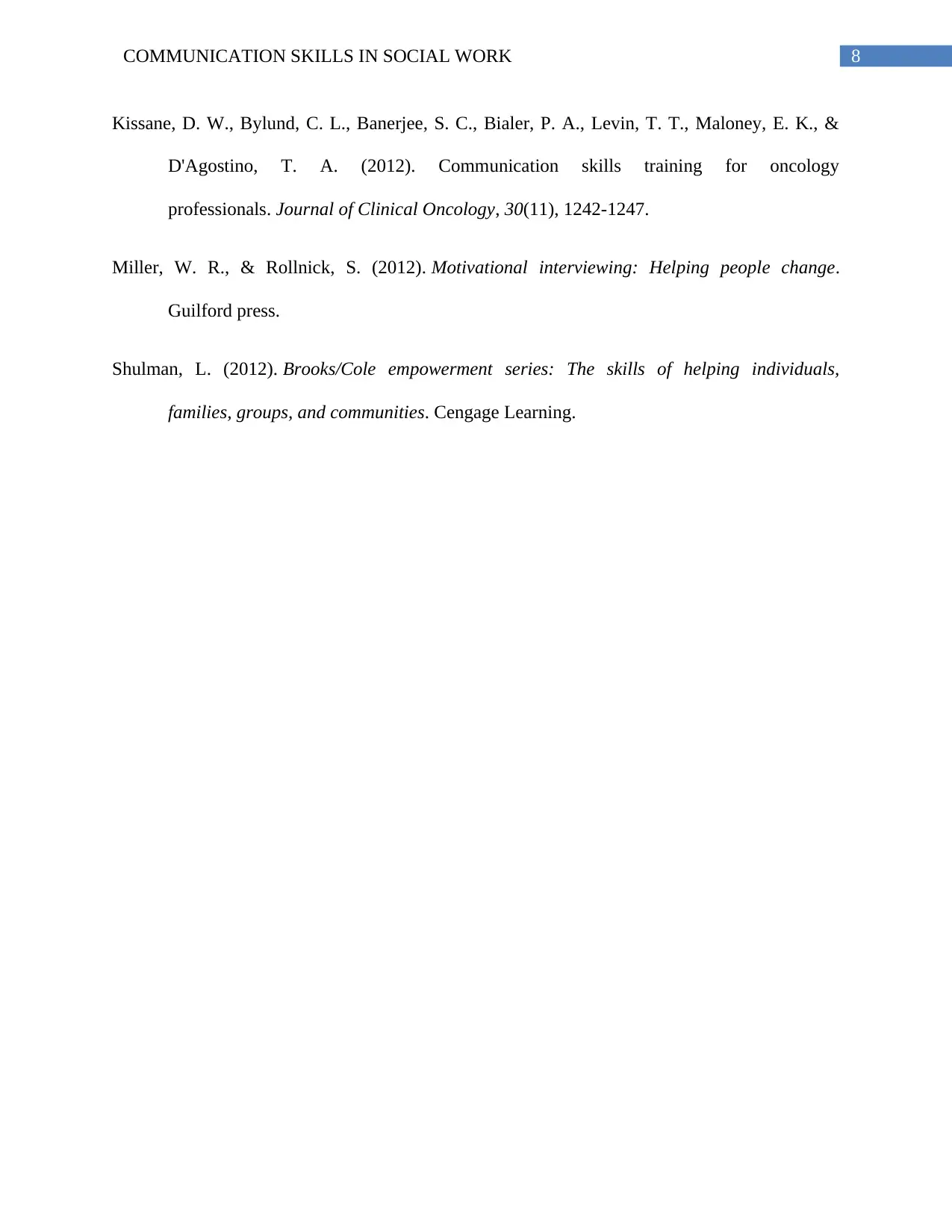
8COMMUNICATION SKILLS IN SOCIAL WORK
Kissane, D. W., Bylund, C. L., Banerjee, S. C., Bialer, P. A., Levin, T. T., Maloney, E. K., &
D'Agostino, T. A. (2012). Communication skills training for oncology
professionals. Journal of Clinical Oncology, 30(11), 1242-1247.
Miller, W. R., & Rollnick, S. (2012). Motivational interviewing: Helping people change.
Guilford press.
Shulman, L. (2012). Brooks/Cole empowerment series: The skills of helping individuals,
families, groups, and communities. Cengage Learning.
Kissane, D. W., Bylund, C. L., Banerjee, S. C., Bialer, P. A., Levin, T. T., Maloney, E. K., &
D'Agostino, T. A. (2012). Communication skills training for oncology
professionals. Journal of Clinical Oncology, 30(11), 1242-1247.
Miller, W. R., & Rollnick, S. (2012). Motivational interviewing: Helping people change.
Guilford press.
Shulman, L. (2012). Brooks/Cole empowerment series: The skills of helping individuals,
families, groups, and communities. Cengage Learning.
1 out of 9
Related Documents
Your All-in-One AI-Powered Toolkit for Academic Success.
+13062052269
info@desklib.com
Available 24*7 on WhatsApp / Email
![[object Object]](/_next/static/media/star-bottom.7253800d.svg)
Unlock your academic potential
© 2024 | Zucol Services PVT LTD | All rights reserved.




